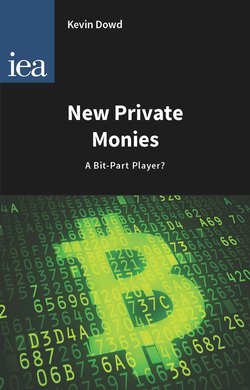Читать книгу New Private Monies - Kevin Dowd - Страница 11
На сайте Литреса книга снята с продажи.
The Liberty Dollar and the law in the land of liberty
ОглавлениеThe attitude of the government towards the Liberty Dollar was initially one of tolerance. However, the attitude then hardened. In 2006 the US Mint issued a press release stating that use of the Liberty Dollar was a federal crime.11 In March 2007, von NotHaus filed a lawsuit against the Mint seeking a declaratory judgement that this allegation was untrue. The government responded with a raid by the FBI and the Secret Service on the Liberty Dollar offices in Evanston, Indiana, on 14 November 2007 in which they seized virtually everything they could, including gold and silver medallions, paper certificates, computers and even the furniture. The warehouse in Idaho where the gold and silver were kept for the Liberty Dollar paper and digital receipts was also raided. Approximately nine tons of gold and silver were seized, even though this was not even the property of the Liberty Dollar company, but that of its clients. This seizure made it impossible for the company to redeem the certificates.
A federal indictment was then brought against von NotHaus and three others in the United States District Court in Statesville, NC, in May 2009, and von NotHaus was arrested on 4 June. He was charged with counterfeiting,12 fraud and conspiracy against the United States.
The first charge can only be described as risible, for two reasons: firstly, counterfeiting requires some attempt to make the ‘fake’ currency look like the ‘real’ one, and yet the Liberty Dollar currency was quite different in appearance from official currency. The medallions themselves were easily distinguishable, even if they shared some similarities such as the dollar sign ‘$’, the words ‘dollar’ and ‘Liberty’ and the year of minting. They differed in obvious ways: they included ‘USA’ (instead of ‘United States of America’) and ‘Trust in God’ (instead of ‘In God We Trust’); they did not feature the Statue of Liberty or the phrase ‘legal tender’; they also had other features not found on US coinage such as an image of Ron Paul, a toll free phone number and even a URL. They also differed from official US coinage in being made from precious metals instead of base metals. If these were ever meant to be counterfeit, they were certainly poor ones – and unnecessarily expensive to produce, being made of precious metal. The Liberty Dollar certificates were also very different from greenbacks. In fact, none were even green. They had the words ‘Negotiable American Liberty Currency Silver [or where appropriate, Gold] Certificate’ boldly emblazoned on one side and ‘Warehouse Receipt’ on the other, and so could hardly be mistaken for US currency. They also bear von NotHaus’s own signature, whereas it is traditional for counterfeiters to keep their handiwork anonymous. They were even a different shape and size from greenbacks.
The second reason why the charge was risible is that any charge of counterfeiting implies fraud and intent to deceive, and yet there was never any evidence of any intent of fraud or misrepresentation.
If the Liberty Dollar is sufficiently similar to official currency to constitute a federal offence, then the government should pursue anyone who issues anything that could be construed as similar to the official currency. After all, there are many other private organisations that issue alternative dollar currencies even within the US. These include: issuers of travellers’ cheques, such as American Express; Parker Brothers, who make the board game ‘Monopoly’; and Disney Corporation, whose Disney Dollars are obvious counterfeits signed off by Scrooge McDuck.
Von NotHaus’s defence was that he did not steal, defraud, misrepresent or force anyone to hold Liberty Dollars or do anything else illegal, and that his customers were satisfied, not least because the value of the Liberty Dollar had risen considerably over time while that of the US dollar depreciated.
This defence was, however, rejected and von NotHaus was convicted on 18 March 2011 of: making coins resembling and similar to United States coins; issuing, passing, selling, and possessing Liberty Dollar coins; uttering and passing unauthorised coins for use as current money; fraud; and conspiracy against the United States. He is currently free on an Appearance Bond, awaiting a potential sentence of up to 22 years in federal prison and a substantial fine.
The suspicion that von NotHaus was singled out because he was seen as subversive would appear to be borne out by a press release issued by the US Attorney’s Office after the conviction. In this press release, US Attorney Anne Tompkins made a series of assertions so absurd that they have already become legendary. In particular, she asserted that: ‘Attempts to undermine the legitimate currency of this country are simply a unique form of domestic terrorism.’
In response to this, it could be noted:
